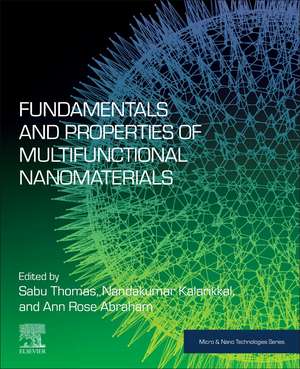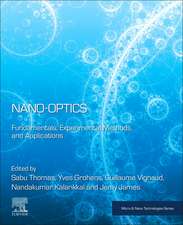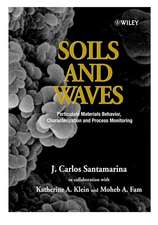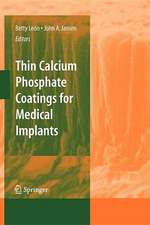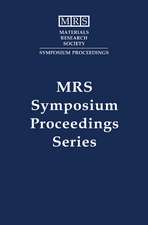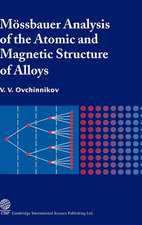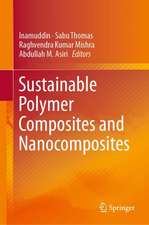Fundamentals and Properties of Multifunctional Nanomaterials: Micro and Nano Technologies
Editat de Sabu Thomas, Nandakumar Kalarikkal, Ann Rose Abrahamen Limba Engleză Paperback – 26 aug 2021
This book is a valuable reference source for researchers in materials science and engineering, as well as in related disciplines, such as chemistry and physics.
- Explains the concepts and fundamental applications of a variety of multifunctional nanomaterials;
- Introduces fundamental principles in the fields of magnetism and multiferroics;
- Addresses ferromagnetics, multiferroics, and carbon nanomaterials.
Din seria Micro and Nano Technologies
- 20%
 Preț: 768.40 lei
Preț: 768.40 lei - 18%
 Preț: 2031.79 lei
Preț: 2031.79 lei - 9%
 Preț: 1043.14 lei
Preț: 1043.14 lei - 9%
 Preț: 987.08 lei
Preț: 987.08 lei -
 Preț: 550.23 lei
Preț: 550.23 lei - 24%
 Preț: 1048.26 lei
Preț: 1048.26 lei - 23%
 Preț: 1100.40 lei
Preț: 1100.40 lei - 28%
 Preț: 738.06 lei
Preț: 738.06 lei - 23%
 Preț: 692.90 lei
Preț: 692.90 lei - 28%
 Preț: 571.91 lei
Preț: 571.91 lei - 9%
 Preț: 733.82 lei
Preț: 733.82 lei - 23%
 Preț: 734.77 lei
Preț: 734.77 lei - 28%
 Preț: 811.47 lei
Preț: 811.47 lei - 16%
 Preț: 766.36 lei
Preț: 766.36 lei - 28%
 Preț: 934.58 lei
Preț: 934.58 lei - 32%
 Preț: 528.10 lei
Preț: 528.10 lei - 23%
 Preț: 810.11 lei
Preț: 810.11 lei - 23%
 Preț: 603.19 lei
Preț: 603.19 lei - 9%
 Preț: 571.98 lei
Preț: 571.98 lei - 28%
 Preț: 825.39 lei
Preț: 825.39 lei -
 Preț: 222.86 lei
Preț: 222.86 lei - 16%
 Preț: 290.93 lei
Preț: 290.93 lei - 19%
 Preț: 659.03 lei
Preț: 659.03 lei - 18%
 Preț: 653.54 lei
Preț: 653.54 lei - 23%
 Preț: 746.61 lei
Preț: 746.61 lei - 9%
 Preț: 1016.51 lei
Preț: 1016.51 lei - 9%
 Preț: 736.59 lei
Preț: 736.59 lei - 29%
 Preț: 803.90 lei
Preț: 803.90 lei - 9%
 Preț: 963.06 lei
Preț: 963.06 lei - 28%
 Preț: 644.55 lei
Preț: 644.55 lei - 23%
 Preț: 813.30 lei
Preț: 813.30 lei - 23%
 Preț: 608.83 lei
Preț: 608.83 lei - 9%
 Preț: 683.99 lei
Preț: 683.99 lei - 9%
 Preț: 792.39 lei
Preț: 792.39 lei - 23%
 Preț: 732.00 lei
Preț: 732.00 lei - 23%
 Preț: 909.30 lei
Preț: 909.30 lei - 28%
 Preț: 698.33 lei
Preț: 698.33 lei - 29%
 Preț: 989.78 lei
Preț: 989.78 lei - 28%
 Preț: 737.80 lei
Preț: 737.80 lei - 9%
 Preț: 848.26 lei
Preț: 848.26 lei - 23%
 Preț: 937.71 lei
Preț: 937.71 lei - 23%
 Preț: 692.32 lei
Preț: 692.32 lei - 24%
 Preț: 869.31 lei
Preț: 869.31 lei - 23%
 Preț: 609.24 lei
Preț: 609.24 lei - 18%
 Preț: 222.37 lei
Preț: 222.37 lei - 28%
 Preț: 816.40 lei
Preț: 816.40 lei - 9%
 Preț: 811.32 lei
Preț: 811.32 lei - 21%
 Preț: 292.28 lei
Preț: 292.28 lei - 9%
 Preț: 807.78 lei
Preț: 807.78 lei - 5%
 Preț: 637.68 lei
Preț: 637.68 lei
Preț: 923.24 lei
Preț vechi: 1187.34 lei
-22% Nou
Puncte Express: 1385
Preț estimativ în valută:
176.66€ • 184.94$ • 146.18£
176.66€ • 184.94$ • 146.18£
Carte tipărită la comandă
Livrare economică 29 martie-12 aprilie
Preluare comenzi: 021 569.72.76
Specificații
ISBN-13: 9780128223529
ISBN-10: 0128223529
Pagini: 682
Dimensiuni: 191 x 235 mm
Greutate: 1.16 kg
Editura: ELSEVIER SCIENCE
Seria Micro and Nano Technologies
ISBN-10: 0128223529
Pagini: 682
Dimensiuni: 191 x 235 mm
Greutate: 1.16 kg
Editura: ELSEVIER SCIENCE
Seria Micro and Nano Technologies
Public țintă
Materials scientists and engineers.Cuprins
1. A glimpse into the fundamentals and properties of multifunctional nanomaterials
Part 1. Nanoscopic solids and transport properties
2. Transport properties of nanoscopic solids as probed by spectroscopic techniques
Part 2. Properties of liquid crystalline nanomaterials
3. Properties of multifunctional bionanomaterials of lipid A-phosphate in liquid phases and quasi-crystalline structures
4. Behavior of nanoparticles within liquid crystal phases
Part 3. Properties of carbon-based nanomaterials
5. Characteristics of carbon nanotubes and their nanocomposites
6. Morphology-correlated mechanical properties of ionic liquid-modified multiwalled carbon nanotubes/poly(vinyl chloride) nanocomposites
7. Fundamentals and properties of multifunctional graphene and graphene-based nanomaterials
8. Fundamental photophysical properties of fluorescent carbon dots and their applications in metal ion sensing and bioimaging
Part 4. Characteristics of magnetic nanomaterials
9. Magnetic properties of doped germanium nanostructures
10. Magnetic and electrochemical characteristics of carbon-modified magnetic nanoparticles
Part 5. Properties of ferroelectric nanomaterials
11. Effect of particle size on structural phase transitions of lithium-modified sodium niobates (LiXNa1-XNbO3 x = 0,0.06 and 0.12)
12. BiFeO3-based multiferroic materials and their properties
Part 6. Properties of plasmonic nanomaterials
13. Multifunctional plasmonic nanomaterials
14. Multifunctional gold nanoparticles for biosensing: effects of surface plasmon resonance, localized surface plasmon resonance, fluorescence, and aggregation
Part 7. Engineered nanomaterials for industrial applications
15. The key role of metal nanoparticle in metal organic frameworks of UiO family (MOFs) for the application of CO2 capture and heterogeneous catalysis
16. Embracing nanotechnology concepts in the electronics industry
17. Conducting polyaniline-based nanocomposites as electromagnetic interference shielding materials
Part 8. Fundamentals of 2D nanomaterials
18. Two-dimensional layered nanosheets: structure and unique properties
19. MoS2, a new perspective beyond graphene
20. Effect of defects and functionalization on mechanical and fracture properties of two-dimensional nanomaterials
Part 9. The impact of nanomaterials on health and safety
21. Occupational health and safety measures of multifunctional nanoparticles in biomedical research and beyond
Part 1. Nanoscopic solids and transport properties
2. Transport properties of nanoscopic solids as probed by spectroscopic techniques
Part 2. Properties of liquid crystalline nanomaterials
3. Properties of multifunctional bionanomaterials of lipid A-phosphate in liquid phases and quasi-crystalline structures
4. Behavior of nanoparticles within liquid crystal phases
Part 3. Properties of carbon-based nanomaterials
5. Characteristics of carbon nanotubes and their nanocomposites
6. Morphology-correlated mechanical properties of ionic liquid-modified multiwalled carbon nanotubes/poly(vinyl chloride) nanocomposites
7. Fundamentals and properties of multifunctional graphene and graphene-based nanomaterials
8. Fundamental photophysical properties of fluorescent carbon dots and their applications in metal ion sensing and bioimaging
Part 4. Characteristics of magnetic nanomaterials
9. Magnetic properties of doped germanium nanostructures
10. Magnetic and electrochemical characteristics of carbon-modified magnetic nanoparticles
Part 5. Properties of ferroelectric nanomaterials
11. Effect of particle size on structural phase transitions of lithium-modified sodium niobates (LiXNa1-XNbO3 x = 0,0.06 and 0.12)
12. BiFeO3-based multiferroic materials and their properties
Part 6. Properties of plasmonic nanomaterials
13. Multifunctional plasmonic nanomaterials
14. Multifunctional gold nanoparticles for biosensing: effects of surface plasmon resonance, localized surface plasmon resonance, fluorescence, and aggregation
Part 7. Engineered nanomaterials for industrial applications
15. The key role of metal nanoparticle in metal organic frameworks of UiO family (MOFs) for the application of CO2 capture and heterogeneous catalysis
16. Embracing nanotechnology concepts in the electronics industry
17. Conducting polyaniline-based nanocomposites as electromagnetic interference shielding materials
Part 8. Fundamentals of 2D nanomaterials
18. Two-dimensional layered nanosheets: structure and unique properties
19. MoS2, a new perspective beyond graphene
20. Effect of defects and functionalization on mechanical and fracture properties of two-dimensional nanomaterials
Part 9. The impact of nanomaterials on health and safety
21. Occupational health and safety measures of multifunctional nanoparticles in biomedical research and beyond
